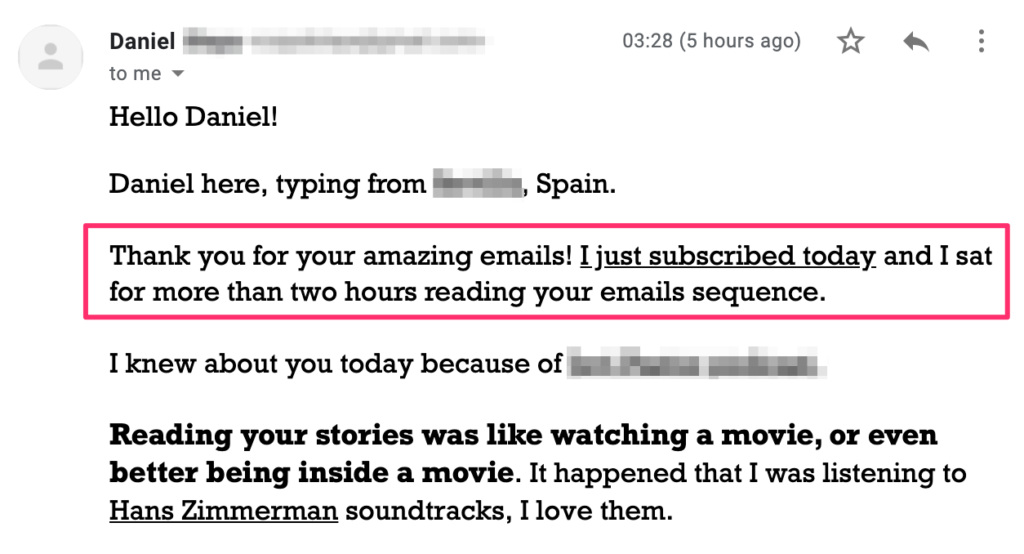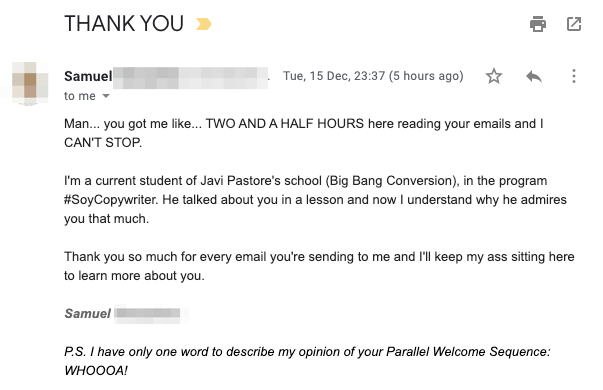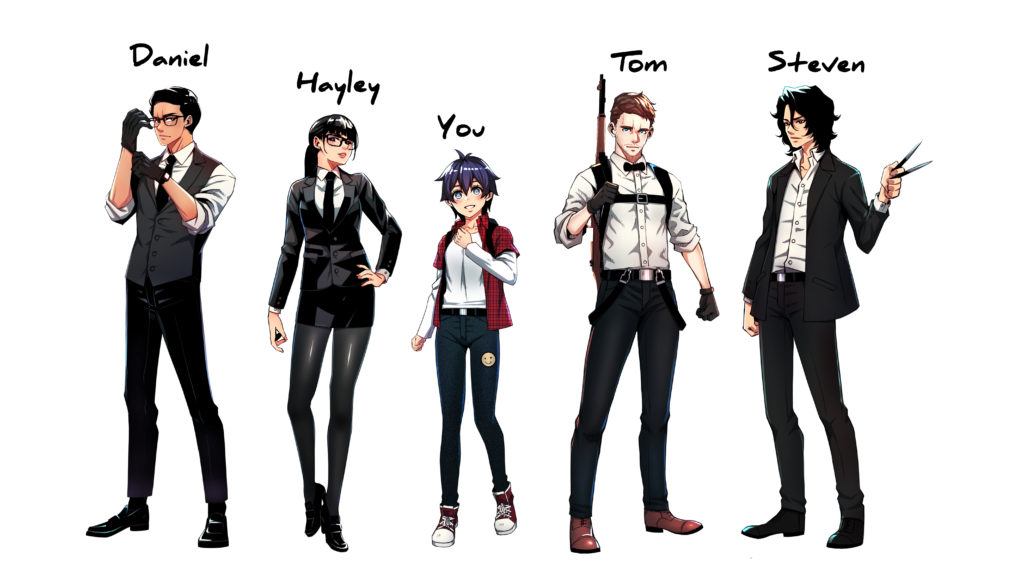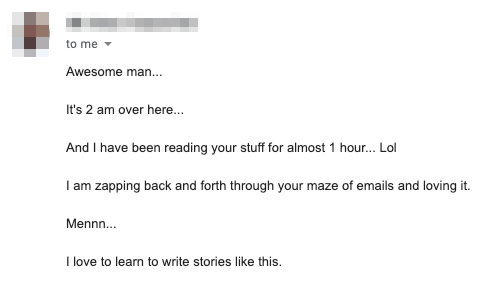(Yes, 200%. No, that’s not a typo.)
In 2020, for my own email list , I invented the “Parallel Welcome Sequence” — a radical, fresh take on the traditional “autoresponder”.
It gets insanely high open rates … binge-level engagement … and leaves subscribers grinning with delight.
with a parallel welcome sequence



Read on to see how it can get literally double the engagement of standard welcome sequences — and how you can set it up too…
By the way, want to see the actual sequence as well as just read about it? Use the button below to sign up to receive the emails.
What if your email sequence had a “magic timer” … that sent your next email at the exact moment someone was checking their inbox?
Your new subscriber picks up their phone …
They start reading emails in their inbox … and …
PING!
Oh look! There’s your new email. Right at the top of their inbox.
You reckon that if you could do that, it might give your open rates and engagement a little bump?
And, not only that, but …
What if you could also …
— Boost the chances those emails ended up in the “Primary” folder (not “Promotions”, “Updates” or *shudder* “Spam”) … without begging people to whitelist you?
— Massively boost the amount of content people consume from you in the days after they join your list?
— Work WITH ‘new subscriber enthusiasm’ (not AGAINST it, like every other autoresponder) — so that rather than “cooling down” your hot leads over days or weeks, you actually warm them up even hotter?
— Do this all while ultra-qualifying your prospects … training your list to click your emails … indoctrinating new leads with your brand … and more?
And what if you could do this in a way that was so unexpected and delightful for your subscribers … that they couldn’t help but tell other people about you?
Well, you can … and it’s called
the “Parallel Welcome Sequence”.
This is a NEW type of onboarding sequence I invented to improve engagement with my own email list in 2020.
I came up with it after thinking about all the assumptions we make about how autoresponders should work:
Why do we assume that …
… people only want one email at a time?
Why do we assume that …
… we should wait 1–3 days before sending another email?
Why do we assume that …
… we should have a fixed period of time to “onboard” our new leads?
This was all “standard advice”, but I didn’t see why it should be. So I decided to build a welcome sequence that challenged those assumptions.
And that’s how I came up with the Parallel Welcome Sequence.
And in this post, I’m going to break down what it is … how it works … and how you can use it for yourself.
Ding-ding! Me again. In case you changed your mind about seeing that sequence. (This post only contains info about it, not the actual emails.) Oh hey, look! An opt-in button! What luck!
So without further ado, allow me to introduce to you …
The Parallel Welcome Sequence
The Parallel Welcome Sequence is a new type of welcome sequence made of two parallel series — a ‘main’ email series, and a ‘parallel’ webpage series — where the reader can click to move forward in the sequence at will.
It looks kinda like this:
(This simplified diagram assumes a three-email sequence. But as you’ll see, I recommend you have more than three emails — I’d say a minimum of ten, because of the way this works. I have more than ten.)
So, how does it work?
Put simply, there are three rules:
PWS Rule #1:
Every email contains a ‘time-travel remote’ link to immediately receive the next email in the sequence.
If you haven’t read about my ‘time-travel remote’ technique yet, the concept is basically this: if the reader clicks a ‘time-travel remote’ link in one email, they automatically get sent the next email instantly. No waiting.
If they don’t click the ‘time-travel remote’ link, the email arrives after the usual interval (in my case, I use 24 hours).
Simple enough, right?
(If you want to learn more about the time-travel remote technique — and how to set it up — check out my post on that here.)
Okay then, moving on …
PWS Rule #2:
Every email sells the ‘time-travel remote’ link as its call-to-action.
Now, this is where I upgraded the pure ‘time-travel remote’ sequence. Instead of merely dropping in a link that you could click, as an afterthought… I built the link into the email itself, as the call-to-action for that email.
Here, I’ll show you what I mean:
In an earlier version of my own Parallel Welcome Sequence, one of the emails was called “My 20 rules for email funnels”.
In the email, there was a list of 19 rules. But when you got to #20, this is what you saw:
Note how the ‘time-travel remote’ link is built right into the email as an inherent part of the CTA. So it feels like the next email is just an extension of this one.
The effect is to make your sequence seem less like a bunch of emails … and more like one long, flowing piece of copy that draws the reader along.
This is actually a delightful, exciting experience for your reader, because nobody else does this.
And it’s why a Parallel Welcome Sequence gets such massive engagement, because people just can’t stop reading.
And now for the final — and most unique — rule …
PWS Rule #3:
The ‘time-travel remote’ links in each email go to individual ‘linker webpages’ that act as a second, parallel sequence.
Now this is where the fun really starts.
Remember, if someone clicks a link in an email, that link has to go somewhere. That’s where the “Linker Webpages” come in. They “catch” the click in any given email.
And so you get a sort of ‘zig-zag’ effect where the reader is bouncing back and forth between a main (email) series, and a parallel (webpage) series:
Which means that — in effect — some readers will end up reading literally 200% of the amount of copy they would be reading if you just had an email sequence. (This is where that headline figure of 200% comes from.)
Now, understand this: everyone in your sequence will get the actual emails, but NOT everyone will click the time-travel remote.
That means not everyone will see the linker webpages. Just the most engaged people. In other words …
These ‘linker webpages’ are prime copy ‘real estate’ for talking to your hottest, most engaged new leads — the ones who are clicking to read more.
Now you tell me, email marketer. What could you do with real estate that you know your hottest, most engaged new leads are seeing?
I’ll tell you some ways I can think of:
Sell Stuff. The linker pages are a prime piece of real estate for selling any products you have. You could even use some or all as mini-sales pages for a product relevant to the email they just read. After all, it’s only your hottest leads reading!
Stitch Your Emails Together. You can just use the linker pages to smoothly join together your emails and make your sequence seem like one long, flowing piece of copy.
Introduce Characters. Good email marketing involves recurring ‘characters’ in your emails. And the linker pages are a great way to introduce them.
And my favourite …
You Can Even Build
A Story Universe!
Now, this isn’t for everyone. Actually, it’s highly unlikely that this will be the best way to use this strategy for YOU.
But for my own parallel (linker webpage) series, I built a separate world — complete with its own storyline, characters, and an alter ego (I’m a mad-scientist-antihero-copywriter who lives in a fortified lab, on a remote island, surrounded by a forest full of dangerous monsters).

To show you what I mean, here’s an excerpt from one of my ‘linker webpages’ in my parallel sequence. Yes, it’s ridiculous and ‘unprofessional’, but it’s overflowing with my personality:
🚨 WARNING! The following excerpt from one of the fantastical stories in my Parallel Welcome Sequence — called “Hunted By Mega-Lions” — is certified ridiculous 🚨
You tap your time-travel remote … and the stadium fades away.
Suddenly, you find yourself standing on a beach.
In front of you is a vast expanse of ocean. You can’t see any signs of land anywhere else.
You turn and look around.
Behind you is the shoreline of a remote island. Thick forest lines the coast. From somewhere inside it, you hear disturbing roars and screeches.
The hair on your arms stands up a little bit.
You’re not sure where you are this time … but something doesn’t feel right.
You slowly turn to look the other way, when—
“Hey!”
A figure jumps out in front of you and startles the living daylights out of you.
“EEEEEEEEEEK!” you squeal. “Who are—”
A hand slams over your mouth.
Then you get a good look at who’s surprised you:
It’s … Daniel Throssell again.
“What on EARTH are you doing outside the lab?” I whisper. “I told you in the first email … it’s dangerous out here. And there’s no way off this island. If you want to live, come with me — quickly. And for goodness’ sake, DON’T scream like that again! They’ll hear!”
“Who’s … ‘they’?” you ask.
But you didn’t need to.
Suddenly, from behind us, something enormous bursts out of the forest … and growls.
It’s like a lion … but it’s three times as big as any lion you’ve ever seen in your life.
Your eyes go wide.
“What … is … that … thing?” you stammer, lifting a finger.
I grit my teeth and scowl as I pull out a machine gun that’s so large it looks comical, and scream:
“Don’t just stand there … RUN!”
Now again, should YOU do stories just like mine? Probably not. This is my brand and my sense of humour. My ideal prospects don’t take themselves too seriously and they enjoy it. You should do whatever suits YOUR personality. You don’t even need to use stories if you don’t want to — use one of the other ideas I gave you above.
That said, it’s okay for the copy you put in your ‘parallel series’ to be a bit more ‘out there’ than your regular emails. Only the most engaged people will see it — and besides, in email marketing it’s better to overdo your weirdness rather than be forgettable.
And come on, who doesn’t like crazy stories about fending off mega-lions with a giant machine gun
And whatever you do, remember:
If a reader does not click ANY of your time-travel remote links, they still get a normal welcome sequence. There is NO downside to this.
So feel free to write your linker pages targeting only the most engaged people. That means you should only include ‘bonus’ content which you don’t mind some of your readers not seeing — like my crazy stories.
So, What Results Can You Expect?
Higher Open Rates
This open rate graph says it all (the Parallel Welcome Sequence is in red, my old ‘standard’ welcome sequence in blue):
As you can see, the Parallel Welcome Sequence is absolutely crushing it when it comes to engagement — even 12 emails in.
And I want to be clear that aside from one or two emails, these are mostly the same emails in each sequence. So it’s not like I wrote way better emails. All I did was structure them according to the three rules I told you about before.
Massive Engagement
It’s obvious from the open rate stats that people in general are a lot more engaged with the emails in this funnel.
But looking at individual readers’ engagement stats is even cooler. Because for the hottest leads, they’re consuming WAY more of my content, WAY faster.
Look at this person who spent a whopping NINETY-TWO MINUTES bingeing my stuff:
That’s absolutely insane. (This isn’t unusual, either — plenty of leads have spent ages just clicking my emails after signing up.)

And another benefit of this is that this person is now immediately receiving my live broadcasts. So they aren’t being withheld from my emails for a few weeks after joining, like they would otherwise be.
Higher Deliverability
Look, email deliverability is a dark art, and I don’t pretend to be an expert. But what I do know is that a few triggers — such as having people open, click, and reply to your first emails — are effectively a “whitelist” that puts you in the Primary inbox. And that’s what the Parallel Welcome Sequence excels at.
In my own (unscientific) tests with this sequence, using new email addresses, all the emails sent entirely to the Primary inbox.
Whether or not this happens for everyone, it’s a no-brainer that getting more people to open, click and reply to your early emails tells Gmail that they want to hear from you.
FAQs About The Parallel Welcome Sequence
“What if my new subscribers race through to the end and I have nothing left to send them?”
Well, firstly, too much engagement isn’t a bad problem to have, right? That said, there are three ways to deal with this problem:
1. Introduce breaks in your emails.
So, every third or fifth email, you could put in a ‘pause’, to slow down the sequence. If you only mail irregularly, this might not be a bad idea. However, I mail daily, and so I’m not a fan of this approach.
2. Email your list more often.
While it’s not the topic of this post, this is just a good idea in general. And if you mail daily — like I do — it doesn’t matter when someone gets out of your welcome sequence. There’s still going to be new emails waiting for them every day.
3. Sell them a product!
Remember, anyone who clicks through your Parallel Welcome Sequence is a hot lead begging for more stuff from you. So SELL them something they can sink their teeth into! Ultimately, clicks and opens are meaningless by themselves. We want them because it means people are seeing our messages SELLING stuff. And so you’d do well to use your last emails/linker webpages in your Parallel Welcome Sequence to sell. (Actually, I think you should sell in ALL of them, and I do … but that’s up to you.)
“How do I do this if I have a lead magnet?”
I actually don’t use a lead magnet because I don’t want to attract anyone who’s not drawn to my emails. And so I build up my welcome sequence (and in particular, my welcome email, “The Dark Room”) as a sort of “opt-in bonus”.

That said, for many people a lead magnet makes sense. So all you need to do is think about how you integrate the lead magnet with your sequence. Too many people deliver a pdf lead magnet in an email that comes BEFORE the welcome email. This is a foolish waste of email real estate. I’d build it into the welcome email, or — even better — deliver it on the first “linker webpage”, which trains people to start clicking them.
And This Is Just The Beginning …
Hopefully you can see how many possibilities there are for using this technique to get more engagement, opens, goodwill and sales from your own email list.
I plan to keep testing and refining this technique, and I’ll be sharing my findings with my email list over the coming months.
So if you’d like to see this sequence in action for yourself … or if you’d like to learn how to set your own up (I’ll probably be creating a training on how to do this) …
Join my email list for daily copywriting tips, and of course, my Parallel Welcome Sequence.
I guarantee it will be the most unique email experience you ever have …
